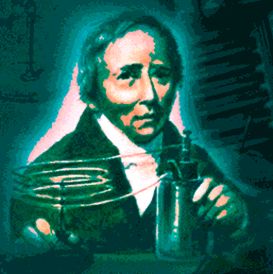Hans Christian Ørsted (1777-1851)
 Oersted was born to Søren Christian Oersted, an apothecary, and Karen Hermansen.
He was born in the small town of Rudkøbing on the island of” Langeland, Denmark, August 14, 1777. While
he was a young boy, Oersted's parents put him and his younger brother in
the care of a German wigmaker and his wife. This was simply because his parents
did not have the time to raise the boys properly, with the demands of their
jobs. While in Germany, the boys learned German and the basics of Latin and
French. They also learned some math. When Hans turned eleven, he went to work
at his fathers pharmacy. It was here that he picked up chemistry. The two boys
never went to school, but in 1794 they both passed the entrance exam at the
University of Copenhagen with honors. There, Hans Christian studied a career
in natural philosopy. This was the start of his enthusiasm with philosophy.
At the University, Oersted studied pharmacy, astronomy, chemistry, and math.
He got a pharmaceutical degree in 1797 with high honors.
Oersted was born to Søren Christian Oersted, an apothecary, and Karen Hermansen.
He was born in the small town of Rudkøbing on the island of” Langeland, Denmark, August 14, 1777. While
he was a young boy, Oersted's parents put him and his younger brother in
the care of a German wigmaker and his wife. This was simply because his parents
did not have the time to raise the boys properly, with the demands of their
jobs. While in Germany, the boys learned German and the basics of Latin and
French. They also learned some math. When Hans turned eleven, he went to work
at his fathers pharmacy. It was here that he picked up chemistry. The two boys
never went to school, but in 1794 they both passed the entrance exam at the
University of Copenhagen with honors. There, Hans Christian studied a career
in natural philosopy. This was the start of his enthusiasm with philosophy.
At the University, Oersted studied pharmacy, astronomy, chemistry, and math.
He got a pharmaceutical degree in 1797 with high honors.
Oersted had studied Naturphilosophie under Schelling himself, and wholeheartedly adopted the view that nature is systematic and unified. (He also thought that the practice of science is a religion.) The fact that he should be seeking a connection between electricity and magnetism was motivated entirely because of his prior philosophical conviction that one must exist. After all, only someone looking to find a connection between electricity and magnetism would consider placing a compass, only affected by magnetic fields, near a current carrying wire, thought to be a purely electrical phenomenon, in the first place.
Oersted's experiment showed that there were underlying connections between what appeared to be quite different physical phenomena, and encouraged other scientists to seek them out. While universal convertibility is not the same as conservation, the two are nonetheless closely related. Thus, a connection or conversion between different phenomena, especially two as outwardly dissimilar as electricity and magnetism, was step towards a unified concept of energy.

Connect with us
Contact us today